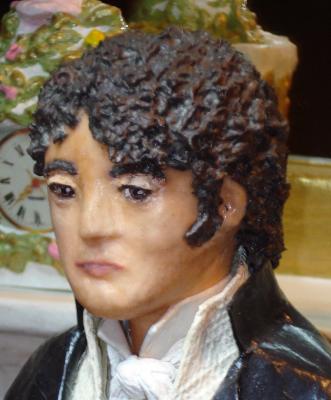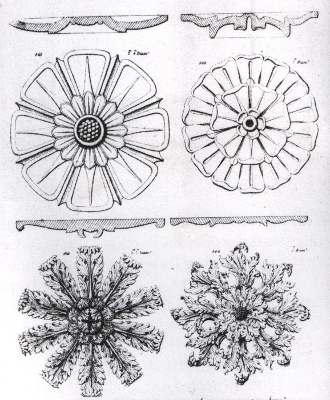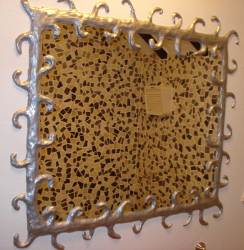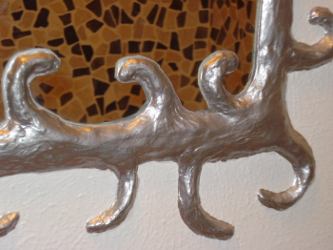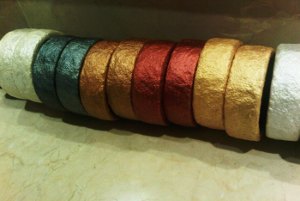What is the difference between papier mache and paper clay?
The answer is - quite a lot!
There seems to be much confusion today about what the difference is between papier mache and paper clay. According to Wikipedia:
Papier-mache:
"(French for 'chewed paper'), alternatively, paper-mache, is a composite material consisting of paper pieces or pulp, sometimes reinforced with textiles, bound with an adhesive such as glue, starch, or wallpaper paste."
Paper clay
"(Sometimes referred to as fibreclay) is any clay body to which processed cellulose fibre (paper being the most common) has been added. Clays that have been converted to paper clay include earthenware, terra cotta, stoneware, porcelain, and bone china."
So what is paper clay?
The origins of paper clay go back hundreds of years. It is what it says on the tin - "paper" and "clay". Ceramicists use it. Paper clay is actually clay slip mixed with paper fibres which are then fired in a kiln. The firing process burns off the paper.
Apparently a lot of sculptors have used paper clay, but played down the "paper" bit so as not to get confused with papier mache - the snobs!
There are products on the market making substitute paper clays (some of which contain no clay or even paper!)
Instant manufactured products
Paper clay
Creative Paperclay is one of these products. It contains no clay, and is air drying so alleviates the need for firing in a kiln.
Papier Mache
Celluclay - Instant papier mache. Comes in powdered form. Just add water. Expensive.
What we really mean
Pulped papier mache forms a "clay like" consistency, which is probably why the term "clay" has sometimes been adopted for papier mache once additives such as plaster, filler etc have been used.
Virtually any paper can be pulped successfully but for a near as you can get it "clay like" consistency, you can’t beat toilet paper. It depends how much you want to go down the recycling route!
Pulped toilet paper is very fine. The paper breaks down very easily in water and becomes very fibrous. You can if you want to add other ingredients such as plaster or filler. You don’t have to of course. I managed to get a very hard and perfectly smooth finish on my faces for Darcy and Elizabeth by using just toilet paper and diluted pva glue.
This diorama was an experiment to see if I could make the whole piece out of basic papier mache with no additives.
A more accurate (though less used these days) name for papier mache with plaster added is Carton Pierre.
Carton Pierre
Wikipedia states...
"A mixture of glue, whiting, paper pulp, and chalk; moulded, dried, and finished to form durable, usually interior, architectural embellishments imitating stone, metal, etc.; a kind of papier mache used for making lightweight cast ornaments where plaster would be too heavy."
Carton Pierre was used extensively in the 19th century for moulded ceiling roses and cornices. It was much lighter and easier to mould than just plaster alone. It was also much cheaper to produce.
Fire surrounds have sometimes been made from Carton Pierre as well as many household items such as mirror and picture frames. You may well have an old painting in what you think is a plaster frame, when in actual fact it could be Carton Pierre. The following image is from "Putting back the style" by Ward Lock.
C.F. Bielefeld was well known for his Carton Pierre mouldings and he made catalogues with a thousand patterns and ornaments:
"Architectural Ornaments" in 1843
"Ornaments In Every Style" in 1853
I first found out about Carton Pierre when I was researching renovating old buildings as I have a Grade II listed home. It gave me the idea to make a decorative pattern around my bathroom mirror. I used newspaper, pva glue and polyfilla.
I didn't require a really smooth finish for my frame, so I used strips of newspaper rather than pulp. I dipped the pieces of paper into the diluted pva and polyfilla mix, then draped them into position around the mirror. I wanted a random pattern of loops and built up the layers gradually. The drying time is much quicker with the filler added. It also dries very quickly in the bowl you mixed it in, so small batches are best. I used my fingers so as not to clog up any brushes. When I was happy with the swirls, I smoothed some paste and filler mix over the entire framework and sealed it with emulsion paint.
I painted the frame silver to resemble metal. This frame has lasted years and years and I have never had to renovate it, despite it being constantly subjected to steam.
An artist who makes beautiful Carton Pierre bangles is Ruth. She has kindly shared her formula with us.
Ruth uses:
- 3 cups all purpose flour
- 2 soft paper tissue rolls (soaked wet and torn into small pieces, excess water removed)
- 2 cups clear craft glue
- 2 tbsp linseed oil (acts as wood preservative)
- 2 tbsp bleach (acts as another preservative)
- Ready mix drywall compound (from Ace Hardware)
- Anything you want to use as a base (as long as its lightweight)
Process
"I combine and mix everything until I achieve the texture I want. If the consistency is too dry, a little water helps and if it's too wet, additional flour can be added.
Tada! You will have your own pulp "Carton Pierre" recipe and ready for crafting. Ruth."
Ruth has the above bangles for sale on Etsy.
Like a lot of us (myself included) Ruth tells me that she doesn't measure everything out exactly. I think you get to judge it for yourself after a few practices. A lot can depend on what type of paper you have used, what you are adding and the humidity around you at the time.
In conclusion
So, let's round off the question of "what is the difference between papier mache and paper clay?". Papier mache is paper and glue (plus fabrics on occasions) and if you add plaster to the equation it becomes Carton Pierre. Paper clay is something else altogether.
I think I blame the companies that jumped on the bandwagon and brought out products that "resemble" the finished items, but are in fact made up of completely different things.
It is better to try not to worry too much about all the components you put into your papier mache. You can add so many different things to give you a "clay like" consistency - just don't add clay!


